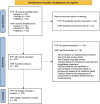Approaches to Decrease Hyperglycemia by Targeting Impaired Hepatic Glucose Homeostasis Using Medicinal Plants
- PMID: 35002743
- PMCID: PMC8733686
- DOI: 10.3389/fphar.2021.809994
Approaches to Decrease Hyperglycemia by Targeting Impaired Hepatic Glucose Homeostasis Using Medicinal Plants
Abstract
Liver plays a pivotal role in maintaining blood glucose levels through complex processes which involve the disposal, storage, and endogenous production of this carbohydrate. Insulin is the hormone responsible for regulating hepatic glucose production and glucose storage as glycogen, thus abnormalities in its function lead to hyperglycemia in obese or diabetic patients because of higher production rates and lower capacity to store glucose. In this context, two different but complementary therapeutic approaches can be highlighted to avoid the hyperglycemia generated by the hepatic insulin resistance: 1) enhancing insulin function by inhibiting the protein tyrosine phosphatase 1B, one of the main enzymes that disrupt the insulin signal, and 2) direct regulation of key enzymes involved in hepatic glucose production and glycogen synthesis/breakdown. It is recognized that medicinal plants are a valuable source of molecules with special properties and a wide range of scaffolds that can improve hepatic glucose metabolism. Some molecules, especially phenolic compounds and terpenoids, exhibit a powerful inhibitory capacity on protein tyrosine phosphatase 1B and decrease the expression or activity of the key enzymes involved in the gluconeogenic pathway, such as phosphoenolpyruvate carboxykinase or glucose 6-phosphatase. This review shed light on the progress made in the past 7 years in medicinal plants capable of improving hepatic glucose homeostasis through the two proposed approaches. We suggest that Coreopsis tinctoria, Lithocarpus polystachyus, and Panax ginseng can be good candidates for developing herbal medicines or phytomedicines that target inhibition of hepatic glucose output as they can modulate the activity of PTP-1B, the expression of gluconeogenic enzymes, and the glycogen content.
Keywords: PTP-1B inhibitors; hepatic glucose output; hyperglycemia; insulin resistance; medicinal plants; natural products.
Copyright © 2021 Mata-Torres, Andrade-Cetto and Espinoza-Hernández.
Conflict of interest statement
The authors declare that the research was conducted in the absence of any commercial or financial relationships that could be construed as a potential conflict of interest.
Figures


Similar articles
-
Hepatic protein phosphatase 1 regulatory subunit 3B (Ppp1r3b) promotes hepatic glycogen synthesis and thereby regulates fasting energy homeostasis.J Biol Chem. 2017 Jun 23;292(25):10444-10454. doi: 10.1074/jbc.M116.766329. Epub 2017 May 4. J Biol Chem. 2017. PMID: 28473467 Free PMC article.
-
Liver-specific inducible nitric-oxide synthase expression is sufficient to cause hepatic insulin resistance and mild hyperglycemia in mice.J Biol Chem. 2011 Oct 7;286(40):34959-75. doi: 10.1074/jbc.M110.187666. Epub 2011 Aug 16. J Biol Chem. 2011. PMID: 21846719 Free PMC article.
-
The Flower Tea Coreopsis tinctoria Increases Insulin Sensitivity and Regulates Hepatic Metabolism in Rats Fed a High-Fat Diet.Endocrinology. 2015 Jun;156(6):2006-18. doi: 10.1210/en.2015-1015. Epub 2015 Mar 16. Endocrinology. 2015. PMID: 25774555
-
Herbal Medicines for Diabetes Management and its Secondary Complications.Curr Diabetes Rev. 2021;17(4):437-456. doi: 10.2174/1573399816666201103143225. Curr Diabetes Rev. 2021. PMID: 33143632 Review.
-
Cooperation of liver cells in health and disease.Adv Anat Embryol Cell Biol. 2001;161:III-XIII, 1-151. doi: 10.1007/978-3-642-56553-3. Adv Anat Embryol Cell Biol. 2001. PMID: 11729749 Review.
Cited by
-
Proposed mechanisms of action participating in the hypoglycemic effect of the traditionally used Croton guatemalensis Lotsy and junceic acid, its main compound.Front Pharmacol. 2024 Oct 16;15:1436927. doi: 10.3389/fphar.2024.1436927. eCollection 2024. Front Pharmacol. 2024. PMID: 39478960 Free PMC article.
-
Quercetin as an Anti-Diabetic Agent in Rodents-Is It Worth Testing in Humans?Int J Mol Sci. 2025 Jul 31;26(15):7391. doi: 10.3390/ijms26157391. Int J Mol Sci. 2025. PMID: 40806520 Free PMC article. Review.
-
Diabetes-Related Mechanisms of Action Involved in the Therapeutic Effect of Croton Species: A Systematic Review.Plants (Basel). 2023 May 18;12(10):2014. doi: 10.3390/plants12102014. Plants (Basel). 2023. PMID: 37653931 Free PMC article. Review.
-
Role of NLRP3 inflammasome and oxidative stress in hepatic insulin resistance and the ameliorative effect of phytochemical intervention.Front Pharmacol. 2023 Jun 30;14:1188829. doi: 10.3389/fphar.2023.1188829. eCollection 2023. Front Pharmacol. 2023. PMID: 37456758 Free PMC article. Review.
References
-
- Abdel-Rahman R. F., Ezzat S. M., Ogaly H. A., Abd-Elsalam R. M., Hessin A. F., Fekry M. I., et al. (2020). Ficus Deltoidea Extract Down-Regulates Protein Tyrosine Phosphatase 1B Expression in a Rat Model of Type 2 Diabetes Mellitus: a New Insight into its Antidiabetic Mechanism. J. Nutr. Sci. 9, e2. 10.1017/jns.2019.40 - DOI - PMC - PubMed
-
- Abdjul D. B., Yamazaki H., Maarisit W., Rotinsulu H., Wewengkang D. S., Sumilat D. A., et al. (2017). Oleanane Triterpenes with Protein Tyrosine Phosphatase 1B Inhibitory Activity from Aerial Parts of Lantana Camara Collected in Indonesia and Japan. Phytochemistry 144, 106–112. 10.1016/j.phytochem.2017.08.020 - DOI - PubMed
-
- Abdjul D. B., Yamazaki H., Maarisit W., Kirikoshi R., Takahashi O., Losung F., et al. (2018). Protein Tyrosine Phosphatase 1B Inhibitory Components and a New Unique N -alkylamide Derivative with an Endoperoxide Bridge from Aerial Parts of Indonesian Spilanthes Paniculata. Phytochemistry Lett. 24, 71–74. 10.1016/j.phytol.2018.01.013 - DOI
Publication types
LinkOut - more resources
Full Text Sources
Miscellaneous

